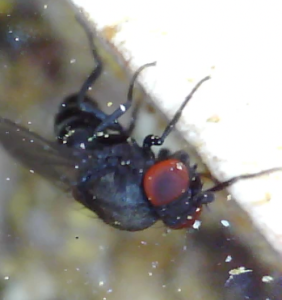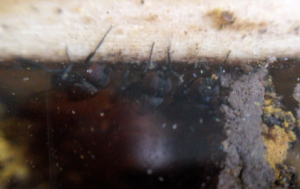The Houdini fly (Cacoexenus indagator) escape artist that uses its head!
The adult flies are a little similar to fruit flies and have large bright red eyes. They are one of the main cleptoparasites of Red mason bees. They loiter around nests and nest site entrances and randomly enter a nearby nest cavity. The adult female mason bees barely give them a second glance, so busy are they in their tasks. The only times I have watched females chase away the fly is when the fly is actually inside the nest cavity whilst the female is present. When the female bee leaves the nest, the fly nips in and lays her eggs on the pollen store and exits, open cell parasitism. How many she lays could depend upon a number of factors, e.g. how much time she feels she has, amount of pollen stored, whether nectar is stored, how many other eggs are already inside and how many eggs she has left to lay. So the longer a female bee is away from her nest, the more likelihood there is of her being targeted by a these pests. Managing them, by loose cell management, the method I use, will significantly reduce their numbers and be beneficial for the next generation of bees.
The fly larvae, depending upon how many hatched, outcompete the bee larvae for the pollen/nectar provisions and are also known to eat the egg or bee larva, (see English summary!)At times, if there are only a couple fly larvae, the bee larva may survive but it will be a smaller bee having less food available due to the competition. You can see a photo of this in the video.
Filming preparation
I had cleared out the Red mason cocoons the previous autumn and kept the fly larvae in a plastic container for this experiment, leaving the mud partitioned walls in situ. None of the innermost cells had been parasitised by the fly, nor had any larvae reached the vestibulum cell. Cells nearing the middle onwards towards the exit were. On 2/1/14 as none of the larvae had entered the vestibulum cell of their respective cavities, I placed the larvae inside various cells, some at the uttermost rear, some in the middle and some near the front of several cavities. The transparent window was replaced and loosened slightly from the observation nest box. Different numbers went into each cell, with some containing 2 and others with more. The flies emerged over several days, in early from May 15. Over the course of the experiment in some cells you could have fully formed adults, a few days old, newly emerged flies with folded wings and pupae.
All escape attempts took place the top of an exit mud wall.
The adults walked around the uppermost of the cell walls they were enclosed in. Similarly along the available lengths of cavities that had no sealed mud walls, or those they had breached. They were filmed working together to make a small hole at the top of a mud wall, where it joined the side wall. Walking along the top of the side wall they would probe with their legs, where it meet the window, perhaps to find a larger gap in which to escape. They did the same with the exit mud wall, where they would often try to force their head through any small gaps, again only where the mud wall met the window, not at the bottom or in the middle of the wall. Perhaps where the mud, side wall and window met would allow them some purchase and enable them to use their head blister?
Dead adults
Many fully formed adults could not break out of their cells and died within them or died leaving via the sides and getting stuck under the window. Now being fully formed adults, they had lost the ability to use their bodies as easily. When newly emerged, their bodies were still soft, allowing them to move peristaltically, or slug-like, as well as a fully functional head blister, so died after many attempts to escape.
Newly emerged different strategy?
The newly emerged flies are better equipped to escape from the cells. They are very elastic, have soft bodies, are capable of moving peristaltically, their wings are not fully formed and they have a fully functional head blister which is pumped up to force its way through little gaps or create larger gaps from small gaps. On the second day of filming, I started to see a just a few newly emerged escaping via the side walls and not the mud walls. Later the next day I had what I can only describe as a ‘mass break out’ of newly emerged flies which had exited the cells via small gaps between the side walls and the window. I saw that in many cells, where these escapes were occurring, there were a few dead adults, with many more trapped under the window, all easily visible to the newly emerged flies. I just wondered why the first newly emerged did not try to escape via the sides? Did the later emerging flies come to the conclusion that the true exit, via the mud exit, as built by the female bee, was impossible to exit, hence the dead adults in the cells, therefore the only possible chance was to find a small gap and use their soft bodies and fully functional head blister to aid their escape, whilst they still had the body to do so?
They travelled a lot further than any fully formed adult, thanks to their head blister and elasticity. One such fly, photo above, took almost 2 hours to travel from one cavity to the next cavity. Along this journey it remained as a newly emerged fly and not a fully winged hard skinned adult. It died in that form. This was obviously a hard experience physically for that fly and once it made it to the cell to its left, it was greatly deformed and kept on inflating its head, whilst on the floor and inside the new cell. It took 3 days to die in the cell, not capable of any further attempt to exit. Its body was simply too deformed. I suppose the body was not capable of such a prolonged exerting exercise which, under normal circumstances it would not normally have to cope with.
As researchers have found that more nest towards the outer ends of cavities are parasitised by Cacoxenus indagator adults, this begs the question is that because their best possible chance of escape is when they are in a ‘newly emerged’ form and not as a fully grown adult? That makes sense to me. So the further they are from the nest entrance, the less likelihood there is of their escape. Unless of course an adult bee has already broken down any preceding mud walls to facilitate its own escape.
In all of the attempts I saw, the flies attempted to breach the correct exit. Even the newly emerged did this, with dead flies in the cells but wasted little time trying and left via the side all or even the rear if there was a sufficient gap to try for an escape. The flies can live for several days without food or fluids.
The work and film by Erhard Strohm, inspired me to undertake this experiment! “How can cleptoparasitic drosophilid flies emerge from the closed brood cells of the red Mason bee? “ Physiological Entomology (2011) 36, 77–83
Beware! Is your ‘bee hotel’ a nursery for disease and pests?
With thanks to Rosita Moenen, Bennekom, The Netherlands for her valuable input.




Sadly not one mason bee cocoon this year George
Marian
My worst year that I can remember Marian 🙁
Fantastic observations and video, I had never wondered how the flies would emerge from the sealed cells (especially if the bees die in their cells). Do you think they would wait normally for bees to emerge first from the rear cells?
Thanks Africa. I think that they would not know whereabouts they were in the cavities, near the front or at the rear. They would not know if any bees were behind them, so I think they would immediately try to escape and not wait on the off chance a bee might emerge behind them. When they first emerged I saw each and every one try to exit. HTH, Cheers George
What amazing video…
I do hope you have better luck the mason bees this year. Thank you, George.
Hi Jo, I have already seen a few of my cells infested with the fly larvae. Other than standing around all day chasing adults they are difficult to be rid of. Easy to deal with the larvae in the cells though! Cheers, G
desperately cleaning and replacing all my canes.tubes and rolled paper tubes.
storing any viable safely.
some males emerged 2015 but did not see any females.
are we spreading disease by encouraging nesting in one area i.e. a bug box?
Will email you shortly Lewis, George